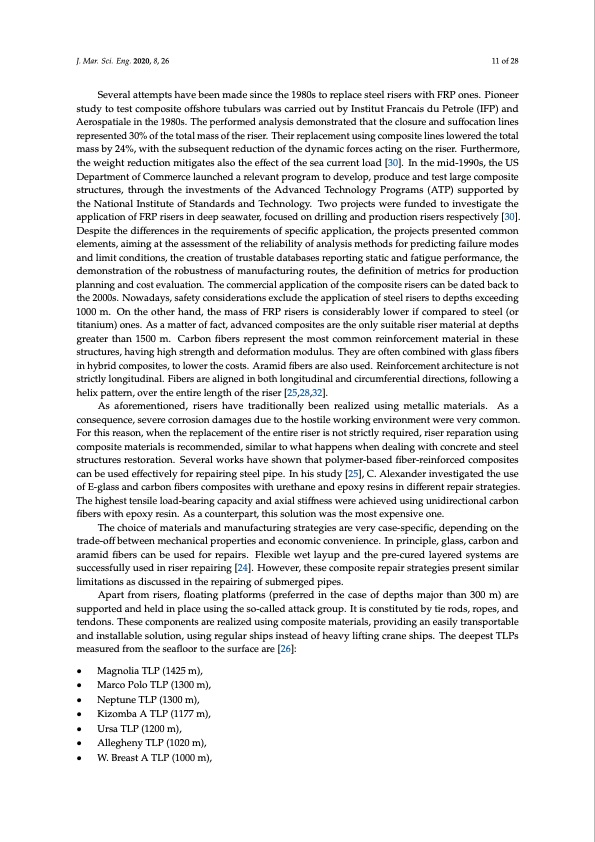
PDF Publication Title:
Text from PDF Page: 011
J. Mar. Sci. Eng. 2020, 8, 26 11 of 28 Several attempts have been made since the 1980s to replace steel risers with FRP ones. Pioneer study to test composite offshore tubulars was carried out by Institut Francais du Petrole (IFP) and Aerospatiale in the 1980s. The performed analysis demonstrated that the closure and suffocation lines represented 30% of the total mass of the riser. Their replacement using composite lines lowered the total mass by 24%, with the subsequent reduction of the dynamic forces acting on the riser. Furthermore, the weight reduction mitigates also the effect of the sea current load [30]. In the mid-1990s, the US Department of Commerce launched a relevant program to develop, produce and test large composite structures, through the investments of the Advanced Technology Programs (ATP) supported by the National Institute of Standards and Technology. Two projects were funded to investigate the application of FRP risers in deep seawater, focused on drilling and production risers respectively [30]. Despite the differences in the requirements of specific application, the projects presented common elements, aiming at the assessment of the reliability of analysis methods for predicting failure modes and limit conditions, the creation of trustable databases reporting static and fatigue performance, the demonstration of the robustness of manufacturing routes, the definition of metrics for production planning and cost evaluation. The commercial application of the composite risers can be dated back to the 2000s. Nowadays, safety considerations exclude the application of steel risers to depths exceeding 1000 m. On the other hand, the mass of FRP risers is considerably lower if compared to steel (or titanium) ones. As a matter of fact, advanced composites are the only suitable riser material at depths greater than 1500 m. Carbon fibers represent the most common reinforcement material in these structures, having high strength and deformation modulus. They are often combined with glass fibers in hybrid composites, to lower the costs. Aramid fibers are also used. Reinforcement architecture is not strictly longitudinal. Fibers are aligned in both longitudinal and circumferential directions, following a helix pattern, over the entire length of the riser [25,28,32]. As aforementioned, risers have traditionally been realized using metallic materials. As a consequence, severe corrosion damages due to the hostile working environment were very common. For this reason, when the replacement of the entire riser is not strictly required, riser reparation using composite materials is recommended, similar to what happens when dealing with concrete and steel structures restoration. Several works have shown that polymer-based fiber-reinforced composites can be used effectively for repairing steel pipe. In his study [25], C. Alexander investigated the use of E-glass and carbon fibers composites with urethane and epoxy resins in different repair strategies. The highest tensile load-bearing capacity and axial stiffness were achieved using unidirectional carbon fibers with epoxy resin. As a counterpart, this solution was the most expensive one. The choice of materials and manufacturing strategies are very case-specific, depending on the trade-off between mechanical properties and economic convenience. In principle, glass, carbon and aramid fibers can be used for repairs. Flexible wet layup and the pre-cured layered systems are successfully used in riser repairing [24]. However, these composite repair strategies present similar limitations as discussed in the repairing of submerged pipes. Apart from risers, floating platforms (preferred in the case of depths major than 300 m) are supported and held in place using the so-called attack group. It is constituted by tie rods, ropes, and tendons. These components are realized using composite materials, providing an easily transportable and installable solution, using regular ships instead of heavy lifting crane ships. The deepest TLPs measured from the seafloor to the surface are [26]: • Magnolia TLP (1425 m), • Marco Polo TLP (1300 m), • Neptune TLP (1300 m), • Kizomba A TLP (1177 m), • Ursa TLP (1200 m), • Allegheny TLP (1020 m), • W. Breast A TLP (1000 m),PDF Image | Marine Application of Fiber Reinforced Composites

PDF Search Title:
Marine Application of Fiber Reinforced CompositesOriginal File Name Searched:
jmse-08-00026.pdfDIY PDF Search: Google It | Yahoo | Bing
Development of a solar powered Electric Ship The Electricship website originally started off as a project to develop a comprehensive renewable, affordable, modular electric ship... More Info
Modular Boat Hull Composite The case for a unsinkable, modular composite hybrid boat hull... More Info
MS Burgenstock Hybrid Electric Catamaran Lake Lucerne Unique shuttle servicing Lucerne to the Burgenstock Resort... More Info
Ground Power Unit GPU Powered by Lithium Ion Batteries The goal of the Ground Power Unit is to provide a readily accessible, modular, ready-to-power solution for remote power... More Info
| CONTACT TEL: 608-238-6001 Email: greg@electricship.com | RSS | AMP |